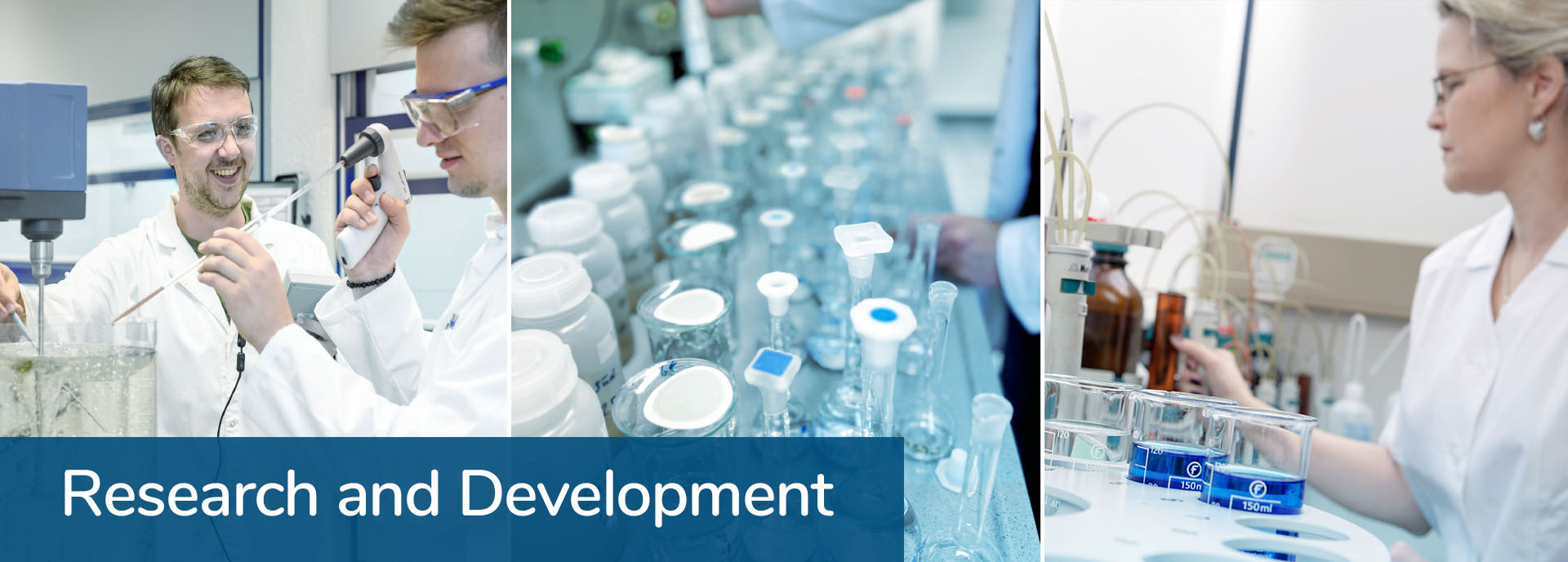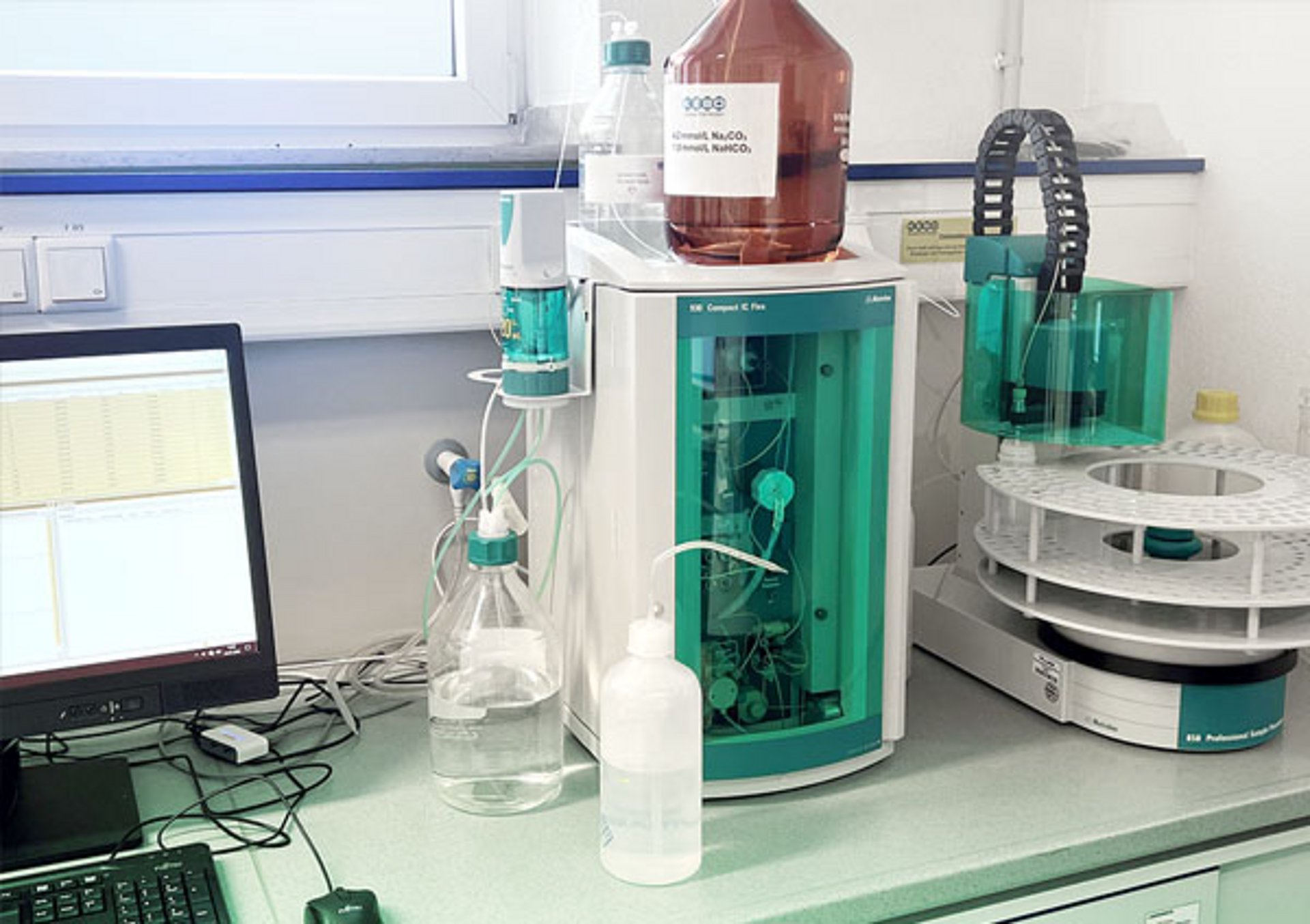

Chemical analysis is our element
Our team will be happy to advise you on all matters relating to chemical cleaning, corrosion protection, viscosity reducers, scale preventers, water treatment and conditioning, and much more.
At the beginning of the joint journey with our customers is the analysis. We use state-of-the-art chemical analysis methods to identify and quantify the composition of substances and substance mixtures down to the smallest detail. We continuously invest in the latest technologies to provide our customers with innovative and efficient solutions.
Our expertise and years of experience enable us to act as a trusted partner for companies in a wide range of industries. For example, we specialize in the development and manufacture of high-quality products used in various areas of the food industry, including sugar production, potato processing, starch production, yeast production and fermentation. Likewise, our customers include companies in the water treatment and steel industries.
Our analyses provide the necessary answers to success-critical questions, such as the composition and density of deposits, in order to develop customized cleaning solutions, reduce foam development in the various process stages or provide the right protection against corrosion. Our goal is always to improve our customers' production processes and increase their efficiency.
Dimensional analysis by means of automatic titration
Improving production processes is also done, among other things, through optimal cleaning. Our team develops effective cleaners for you to efficiently remove scale. In doing so, we first ask ourselves the questions:
1 What is the deposits' composition?
2 How thick is the scale?
3 What is the material?
After that, we develop a dimensional analysis using automatic titration. With the ""Potentiometric Titration Principle"" a known substance, whose concentration is unknown, is implemented in a specific chemical reaction with a measured solution, whose concentration is precisely known. The volume of the consumed measuring solution is measured and the unknown concentration of the sample solution is calculated.
Analysis of trace elements by ICP OES
In ICP-OES analysis, the sample solution is introduced into an inductively coupled argon plasma via a pneumatic atomizer system, and the elements are atomized and emit a specific light. The method allows the simultaneous determination of all metals and some nonmetals.


Determination of dissolved anions with the ion chromatograph
In ion chromatography, a solution is passed over a column of charged resin and the ion compounds are ""held"" to it for a specific time. Due to the preceding calibration, the anions can thus be determined precisely.
Optimum cleaning performance and lasting protection
Our dedicated team is passionate about developing and researching advanced corrosion inhibitors to best protect your materials and equipment.
Our focus is on designing and conducting comprehensive trials and testing to ensure the effectiveness of our products under real-life conditions. In doing so, we use state-of-the-art equipment and perform detailed analyses to achieve precise results.
Our goal is to provide customized solutions that meet the specific requirements of your application / production facility. By working closely with our customers, we can develop customized corrosion protection strategies that provide lasting protection and optimal performance.
Without the use and protection of inhibitors, acid attack occurs on the metal surfaces being cleaned with resulting ""pitting"" (metal damage).
As a leading provider of corrosion protection solutions, we are committed to continuous research and innovation to deliver the best products and technologies on the market.
This is evident in our inhibited cleaners or, if you are already using an acid, our inhibitors; they form a monomolecular protective film on the metal surface without interfering with the dissolution of the deposit by acids. In this way, we ensure efficient cleaning and protection of the substrate in equal measure.


In alkaline cleaning
Alkalis are substances that form lyes together with water. That is why alkaline cleaners are also called lyes. As with acids, lyes also vary in strength. Lyes have a pH value greater than 7. The higher the value, the more caustic the alkali.
Alkaline cleaners are good for removing organic deposits such as oil, grease, grime and wax. They dissolve the organic residues and greasy soiling.
Principally: The more stubborn the soiling from these substances, the higher the concentration of the alkaline product should be or the cleaning time must be extended. Caution, on the other hand, must be exercised with surfaces whose composition contains organic substances.
The effect of alkaline cleaners can be described as follows:
- Use with organic substances: Alkaline cleaners, such as caustic soda, have a strong effect on organic soiling. The high alkalinity of the cleaners enables them to break down and decompose organic compounds. Additives in the alkaline cleaners, often in the form of surfactants, help to improve the cleaning effect. These surfactants support the caustic soda by infiltrating the cleaning solution in the deposit and thus facilitate the removal of dirt.
- Use with oxalate deposits: Alkaline cleaners can also undermine oxalate deposits. Oxalates are salts of oxalic acid and can be difficult to remove in some cases. As the cleaning solution penetrates the deposit, the oxalic acid is neutralized and converted into calcium carbonate. The conversion of oxalic acid into calcium carbonate enables subsequent acid cleaning. Acid cleaners are effective in removing mineral scale. However, conversion is often sufficient, because the transformation of oxalate into calcium carbonate leads to a change in the molecular structure of the deposit. This in turn can cause the deposit to become more cracked and porous.
In summary, alkaline cleaners, especially in conjunction with additives such as surfactants, allow
effective removal of organic soiling and support in the fight against
stubborn oxalate deposits. However, it is important to note that the chemical transformation of the deposit can lead to
structural changes that affect its properties. Therefore, the use
of such cleaning agents should be done with caution to avoid damage to sensitive surfaces.
.
The products shown on our website are only a selection of our entire product range. There is no universal remedy for the rapid removal of impurities. Some can be removed well with alkaline agents, others better in the acidic range. The large variety of conceivable cleaning problems and the large number of additives, inhibitors and ready-to-use cleaning solutions offered by us make it advisable to obtain detailed advice before starting cleaning.
The same applies to inhibitors, defoamers, scale preventers, corrosion inhibitors, pickling inhibitors, etc. Depending on the plant, material, product and the type of boiler/cooling water is used, different individual challenges arise. We are well equipped for them.
Talk to us, we will be happy to help!
On request, we can analyze deposits in our laboratory and develop a cleaning strategy based on our many years of experience, taking into account the conditions on site.